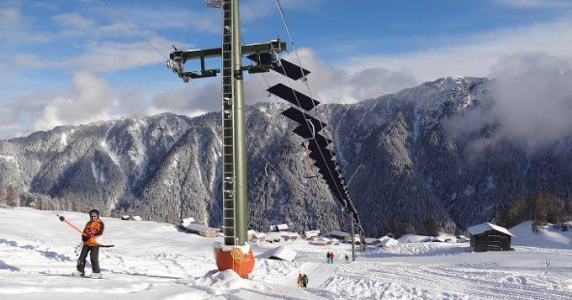Getting a Lift from the Sun

Winter sports lodging businesses like cabins and hotels discovered the advantages of drawing their own power supply from renewable energies some time ago, but the advantages that this resource affords for transporting skiers and snowboarders have been largely overlooked.
Since 2008, however, solar energy’s prospects on the slopes have been improving, and in 2012 took another turn for the better. At several ski areas in Austria and Switzerland, you can now ride to the top of the mountain on solar-powered ski lifts.
“Solar Lift” SkiWorld Wilder Kaiser – Brixental
One of these is the Brixental ski area in Tyrol, Austria, where the solar-powered ski lift, or “Sonnenlift” as it is called, started operating in 2008. This 205-meter-long tow lift is powered exclusively by solar energy and can move about 900 people per hour without producing any CO2. The PV system, which cost around €60,000 and has a surface area of 113 square meters, generates about 12,000 kilowatt hours per year, although the drag lift only uses 9,000 kilowatt hours in the winter. The rest is fed into the public utility grid. Even in inclement weather, the system stores enough energy to operate entirely on solar power.
“Solar Ski Lift” Association Tenna
In the village of Tenna, nestled 1,650 meters above sea level in the Safien Valley in the Swiss canton of Graubünden, another ski lift has been operating on solar energy since 2011. The tow lift, roughly 460 meters in length, uses a sophisticated design mounted directly on the system to produce around 90,000 kilowatt hours of current per year. The “solar wings” attached above the tow rope follow the sun. And because they are mobile, even falling snow is not a problem. They can be tipped remotely, and the snow simply slides off. Incidentally, it also won the Swiss Environmental Award.
The World’s First PV-Powered Chairlift
Since 2012, another Austrian ski lift has run on power from photovoltaics. The Hüttenkopf cableway at the Golm ski and winter sports area in Vorarlberg has harnessed the favorable orientation of the mountain and Golm’s abundant sunlight. Replacing the two-seater lift dating from 1986, the new detachable six-seater chair lift features an integrated PV system and was constructed in just under four months. The base station, top station and “chairlift hub” of the Hüttenkopf cableway feature 312 square meters of PV modules and three SMA inverters. The chairlift, 1,341 meters in length, uses about 180,000 kilowatt hours to power its annual operations of around 1,000 hours. In the future, the integrated PV system will deliver 60,000 kilowatt hours, which is nearly equal to the annual power consumption of 15 single-family homes. This means that the new Hüttenkopf cableway will transport every third guest with solar energy.
Werner Netzer, general manager of the Illwerke tourism office: “This unique project will allow Golm to contribute significantly and set the bar for climate-friendly, sustainable energy use in Alpine tourism.”
World’s First Ski Lift Was Environmentally Friendly Too
We should not only focus on the latest examples without mentioning the world’s first ski lift. Ahead of its time, the “continuous cable lift for bobsledders and skiers” ran on environmentally friendly hydropower from a mill wheel. Farmer and innkeeper Robert Winterhalder (1866-1932) began operating the lift in Schollach, near Eisenbach in the upper Black Forest on February 14, 1908. Winterhalder’s lift measured 280 meters in length covering a height difference of 32 meters. Between the two wheels that formed the circuit between the base and the top station, he stretched a continuous loop over five wood poles, attaching specially designed rails with hoists for the passengers. Unfortunately, the lift was dismantled for raw materials during World War I.
Benchmark Effect
While environmentally friendly ski lifts are just a small step in the right direction, they act as a benchmark, particularly for sustainable tourism. Naturally, this represents just a small portion of the power consumed by a large network of ski lifts, not to mention an entire ski area, but the solutions described here blaze a new trail for the future and for other ski areas as well.

Hi
Can you let me know who provided the technoligy for solar lift
Mini case study
The first solar-powered ski lift
1) Introduction
Nowadays environmentalism takes more importance in our lives than in the past. 2012 is the
international year of renewable energy for all. The project of a small village in Switzerland, Tenna
(canton of Graubünden, Safien Valley) describes perfectly this trend. In 2011 the inhabitants of this
village decided to build a solar-powered ski lift. This is the first of its kind throughout the world.
In this case study we will examine the circumstances of the building of this solar-powered ski-lift, and
then we will continue with explaining this installation. Afterwards we will look at the results of this
new installation.
2) Building background
40 years ago the first ski lift was built in Tenna. In 2011 the concession for the exploitation of this ski
lift fell due and some spare parts were no longer available. The persons in charge suggested various
ideas to replace this ski lift and they found an agreement on a new project: building a solar-powered
ski lift.
Skilift Tenna, the society operating the ski lift, started collecting the money but it was not an easy
task because this installation cost 1.3 millions of Swiss Francs (about one third more than a normal
ski lift). Because of a lack of funds the ski lift could not come into service as planned in December